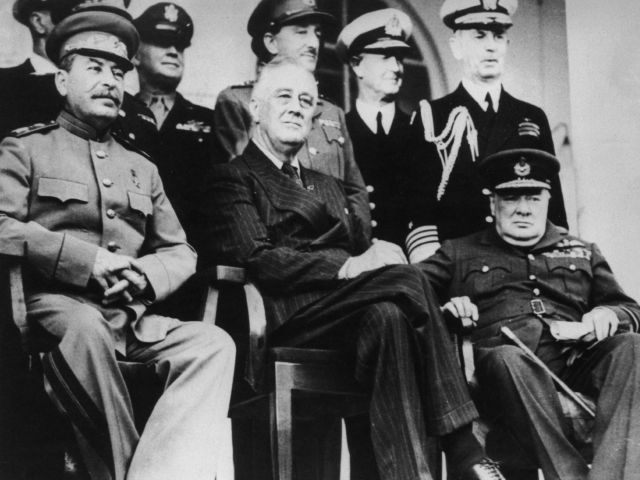A lot has been written through the years about the assassinations of Abraham Lincoln, of John F. Kennedy, and of many others, and about the numerous conspiracy theories that lurk in the shadows of the official narratives. Recently, there has been a great deal of talk of near death experiences involving the bullets of potential assassins, such as that which nearly killed Ronald Reagan.
Each of these assassinations and potential killings had serious and far-reaching consequences that have been discussed by scholars and historians ad infinitum. However, all of these pale by comparison to an elaborate and daring conspiracy known as Unternehmen Weitsprung, or Operation Long Jump.
Long Jump was the biggest assassination conspiracy of the past century, and perhaps of all time. It was a scheme to simultaneously take out Franklin Roosevelt, Winston Churchill and Josef Stalin at the Tehran Conference in 1943. As Churchill himself observed, their Tehran was “the greatest concentration of power that the world had ever seen.” Between them, the Big Three world leaders commanded nearly 70 million troops, most of them engaged in combat against the forces of Adolf Hitler’s Third Reich.
To have killed them all at the same moment, to have suddenly erased this “the greatest concentration of power,” would have changed the course of world history.
Originally hatched in the murky darkness of Nazi Germany’s Sicherheitsdienst, the SD, the covert mischief branch of the notorious SS, Long Jump was equally unprecedented in its scope. It was a brazen notion that was so alluring to the masterminds of the German spy agencies that it became a rare moment of cooperation between Walter Schellenberg, who headed overseas operations for the SD, and his archrival, Admiral Wilhelm Canaris of the Abwehr, German military intelligence. Though Long Jump was initiated with their imprimatur, it soon took on a life of its own, especially after the boots of their hit men touched the dusty ground of wartime Iran.
Like the assassination of Reagan, this audacious scheme did not succeed, but like the 1981 near miss, it came very close to succeeding. Roosevelt himself realized what had almost happened when he told reporters on December 17, 1943 that there had been hundreds of German covert agents in Tehran while the Big Three were meeting there, and that “it would make a pretty good haul if they could get all three of us.”
Why don’t we know more about this potentially earth-shattering conspiracy?
Nobody wanted to talk. Canaris was dead and Schellenberg wrote his memoirs while in Allied custody, so he was not about to admit what had happened. The Allied secret services were happy to let it go unmentioned and unheralded because they knew that it had not been foiled through their own heroic efforts, because it had not. Instead, it failed through a series of improbable flukes that could neither have been planned, nor controlled.
The press might have picked up the thread and looked into what had happened during that week in Tehran when hundreds of German covert agents came close to getting the Big Three, but they did not. In part it was because this was the middle of World War II and they had bigger fish to fry. In part it was because Tehran was on the other side of the world, and it was, as it still remains, a place where secrets are hard to crack. Then too, there was Roosevelt’s casual quip at his press conference that there was “no use going into details.”
Today, when a politician tells a journalist that there is “no use going into details,” it is a red flag that demands a look into the details, but this is now, and that was then.
How do we go into details and find out more about a potentially earth-shattering conspiracy that was swept under the rug so long ago?
Veteran military historian, Bill Yenne has just published Operation Long Jump: Stalin, Roosevelt, Churchill, and the Greatest Assassination Plot in History with Regnery Publishing.

COMMENTS
Please let us know if you're having issues with commenting.